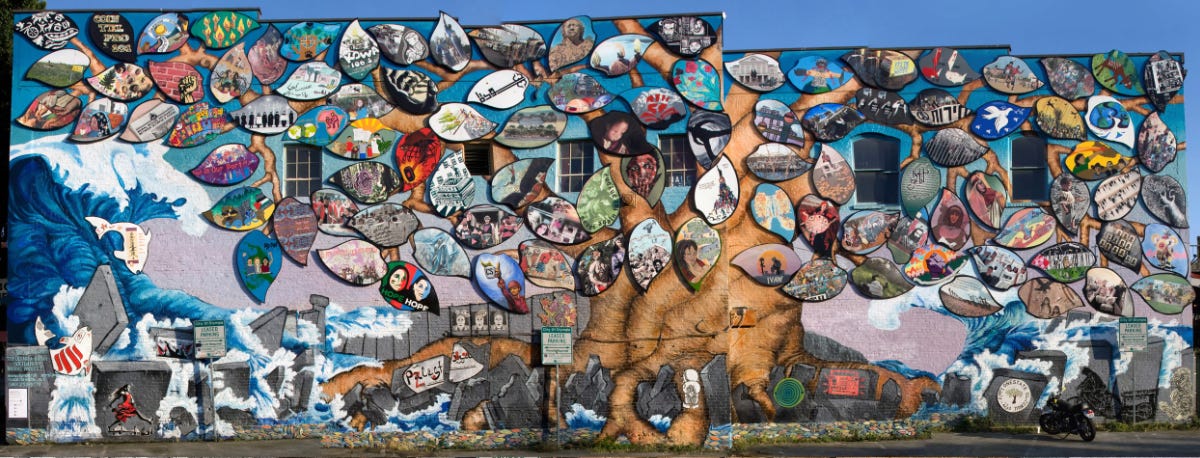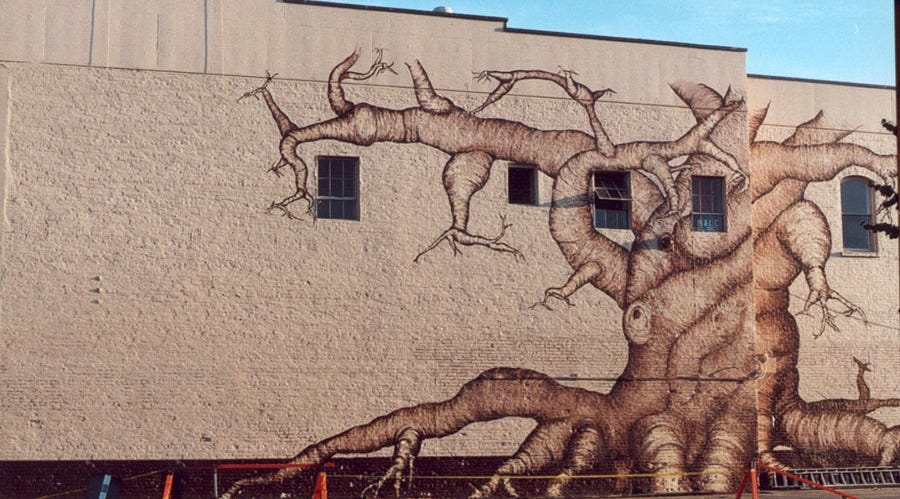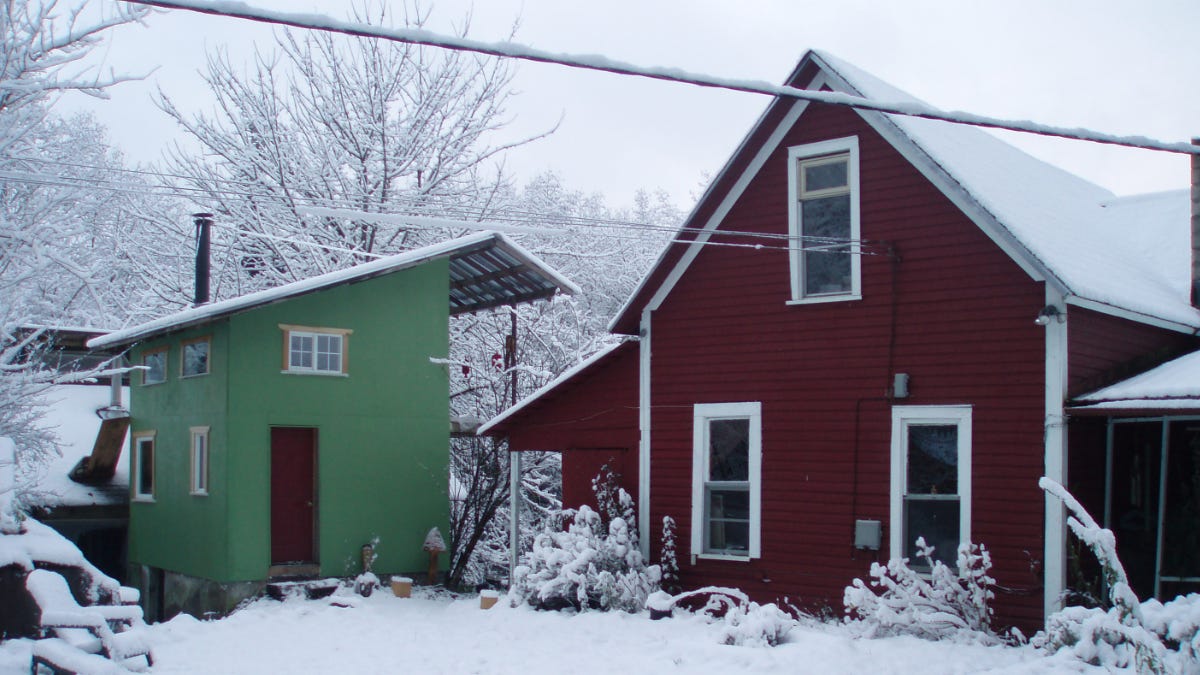Learning to Fly: Art, Justice, and Community (Offering 6.1)
From painting a giant olive tree to living in a root cellar, this offering explores creativity, connection, and discomfort.
Here we enter the fifth phase of Eclosion: Learning to Fly. In it, I step into the world of collaborative public art—and into an intentional community where consensus was both a practice and a pressure. These chapters explore the ways creativity, justice, and relationship stretch and form us.
(This is offering 6.1 of Eclosion: An Artist’s Path to Power and Peace. If you’re new here, start at the beginning. Or visit my Memoir Hub for a full table of contents with links.)
Ecology meets Equity
While Shon and I settled into a rhythm together, my work was also shifting—pulling me closer to art, to justice, and to something bigger than both.
I had an opportunity to take part in my first large-scale collaborative mural project, which later became known as the Olympia-Rafah Solidarity Mural Project. I was offered the role of Design Coordinator for Phase 1. Working on a mural of this scale—the wall we were planning to paint was 46 feet tall and 78 feet long—was a dream come true. The only problem was that the subject matter was way outside of my comfort zone, due to the politicized nature of the mural.
Political activism does not come easily or naturally to me. I didn’t grow up talking about politics. I grew up hearing that politics was beyond me and outside of my control. I rarely saw political conversations modeled in my family or my community. Even though I went to a liberal arts college, I shied away from anything political. I studied biology and ecology, with a bit of art sprinkled in here and there. I love the natural world—the forests and the prairies, the mountains and the oceans, plants and animals, sun and moon. I love these natural elements so much that I wanted to protect them. Working to preserve habitats, the survival of species, even reducing carbon emissions were causes that I could stand behind. It was people that were hard. People, with all their unexpected actions and reactions, and especially their messy emotions. Ironically, I went from avoiding all things political to being involved in one of the most politically controversial conflicts of our time.
In 2004, a young community member, Rachel Corrie, was crushed to death by an Israeli bulldozer in Palestine. She died standing up for the rights of others, using her body to protect the home of a Palestinian family. While I didn’t know her personally, she was a dear friend of one of my closest friends and loved by many in my community. At the time, I knew very little about the Palestinian struggle and it was hard for me to understand how she was able to sacrifice her safety, and ultimately her life, in such a way. Learning about her work, her beliefs, and witnessing how her death mobilized our community was both heart-wrenching and inspiring.
Rachel’s parents, Cindy and Craig Corrie, formed the Rachel Corrie Foundation for Peace and Justice as a way to continue the work Rachael was so passionate about and to honor her legacy. To this day Cindy and Craig are pillars in our community’s social justice network as they continue to fight for Palestinian liberation and justice. In response to Rachel’s murder, and the continued atrocities in Palestine, Art Forces joined up with the Rachel Corrie Foundation in 2006 to co-create what eventually became The Olympia-Rafah Solidarity Mural Project, of which I was the Phase 1 Design Coordinator.
Even though I felt uncertain and unqualified to work on such a fraught social justice issue focused on the human rights of the Palestinian people, I was excited by the large scale of the project, and the challenge of designing the mural literally around corners of the building. Add in the mural’s collaborative nature, and I was hooked.
In my role as Design Coordinator, I had the honor of finalizing the design and organizing volunteers in the painting of a massive bare-leaf olive tree, twisted and gnarled, on the walls of the Labor Temple, in downtown Olympia, WA.
Olive trees have deep significance for Palestinian people. Many Palestinians depend on olive trees for their livelihoods. Those ancient groves are seen as symbols of rootedness in an age of displacement, self-sufficiency in times of hardship, and peace in periods of war. The olive tree became the canvas for the next phases of the mural, the brainchild of Susan Greene of Art Forces, ultimately including hundreds of individual artworks from artists and organizations around the world. To this day it is used as an organizing tool for Palestinian rights.

During my time with that project, I heard stories and met people who were working to end the Israeli occupation and bring peace and justice to that region of the world. It opened me up to an entire world of political organizing. I was primarily involved in the first phase of that project and even worked for the Rachel Corrie Foundation for Peace and Justice for a short time. Even so, I rarely talked about the Israel Palestine conflict outside of my work with that organization. I had no confidence in my ability to do it justice. It was just one more thing that I was afraid of.
It did, however, encourage me to begin researching and understanding social justice on a larger scale. I began learning that so much of what I was taught, and how I moved through the world, was based on colonization—systems built by and for those in power, often with the erasure of indigenous cultures and at the expense of others. I began to see my own privilege and responsibility as a white person. I began to understand that we can’t save habitats or species without considering people—that hunger and racism and human health were inextricably linked to the environment, that making sure people’s basic needs are met is essential for creating a better world.
Once I understood that social justice is integral to environmental protection, my work began to edge from environmental education into environmental justice. Over time, climate justice became a core tenet of my work. And it did take time. I was still in my twenties, still trying to figure out who I was, and I was more interested in having fun with my people than working towards justice.
Delphinia
After “dating like normal people” for a while, Shon and I decided to take the next step and move in together. The thing was, he was deeply rooted in the intentional community where he lived, Delphinia, which he had co-founded years before. It was Shon who had drafted Delphinia’s governing documents. It was his leadership that kept the group on track, eventually resulting in the purchase of 36-acres of land from the former owner. As part of the purchase agreement, they donated over half of the land to the Capitol Land Trust, protecting it from development and logging for perpetuity. Delphinia was his baby. If I wanted to live with Shon, I had to move in with him.
But it wasn’t quite that simple. Delphinia had a policy that anyone who wanted to live there, even significant others of current members, had to apply and be accepted by everyone. It was a logical policy. And I hated it. I’d been joining family dinners and spending time at Delphinia with Shon for the past year and a half. I knew everyone there and was angry that there was even a question that I might not belong. I irritably filled out the application form, putting very little energy into it and completely skipped the whimsical question about writing a hypothetical ‘Personal Ad’ sharing why I was a good match for Delphinia. My resentment at having to go through this project was simple: I was afraid of rejection.
None-the-less, they did accept me, and I moved into Shon’s tiny 200-square foot cabin, the Root Cellar. It was cozy and comfy, even though our bathroom consisted of a 5-gallon bucket composting toilet in the unfinished, walk-in basement, which really was once a root cellar. It was so unfinished it didn’t even have a door for privacy. The cabin itself had a tiny living room/kitchen with cold running water and a loft with our bed and desk. The nearby farmhouse provided hot showers, a larger kitchen and gathering area, and housed our shared studio space.
I couldn’t imagine living in such a small space with anyone else, but with Shon, it worked. With his watery, Pisces nature, able to move around obstacles with ease and settle in wherever there was space, it never felt crowded.
Shon thrived in community. His analytic mind was balanced with his joy of being in the moment. His idea of a perfect day was one where he could follow his curiosity wherever it led him. That might look like doing a little writing, then wandering around Delphinia, stopping to chat with whoever was around. Maybe he’d join in some garden work, or head to his studio and play with clay, or wander barefoot into the forest, where he might find some invasive ivy to pull or mushrooms to harvest.
At Delphinia, the community was the core. The eight to twelve of us living there had community meetings or family dinners weekly. Everyone took turns facilitating the meetings and hosting dinners in the farmhouse or cabins scattered across the land. Shon was not only great at making everyone feel included at a potluck or music night, he was a skilled facilitator, making sure everyone’s voice was heard and keeping us on topic during meetings. I learned a lot about community and facilitation by living there with him.
While there were a lot of fun and lighthearted times at Delphinia, there was also a lot of tension. Everything from painting the walls in your room or cabin, to what plants to plant in the garden, was done by consensus—meaning that everyone in the community had to agree, or at least say they wouldn’t block the idea. Everything. And the lines on who had ownership in what were often unclear.
Early on in my time there, I weeded the garden. While I thought I was being helpful, another community member was crushed because I’d weeded some volunteer seedlings she’d been nurturing. It didn’t matter that they were growing in the path and around the squash plants; she had a vision, and I unknowingly destroyed it. I did not like being in the wrong, especially when I thought I was doing right.
In the first year that I lived there, another community member interrupted me during a meeting. When I called her on it, she responded by yelling at me, trying to turn the situation around, saying I’d interrupted her first. Words of denial caught inside as I froze at the unexpected onslaught, even as my face burned with embarrassment. When she stopped yelling, the meeting just kept on going. I couldn’t believe that her behavior was okay, but I was too shocked to speak up. After a few moments, Shon broke in and calmly called the other member on her actions. Her response was to stand up, smash a ceramic mug on the floor, threaten everyone, and storm out.
I was appalled. It’s not that my behavior was any better, really, I just kept it further under wraps, only losing it with others in private. She eventually left, but there was always some conflict with other community members that needed processing. It took a lot of time and energy. We sometimes joked that living there was like being inside of a human growth machine. I learned a lot of communication skills during that time. Still, I was emotionally fragile, and living in community was hard for me. I could be sarcastic, erratic, and unstable, which, over time, alienated a lot of people.
Have you ever found yourself changed by a project—or a place—that pulled you outside your comfort zone? How did you stay grounded while growing?



